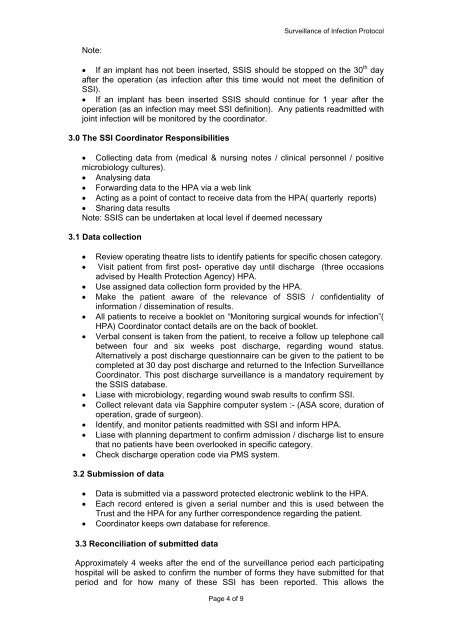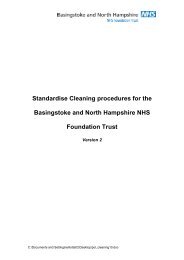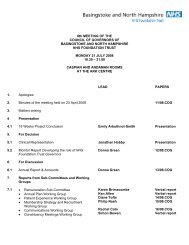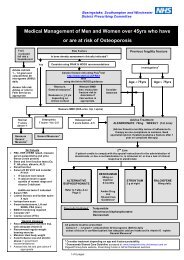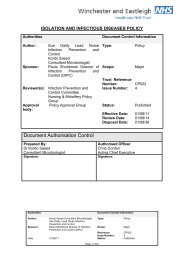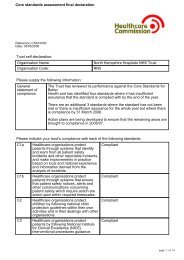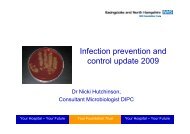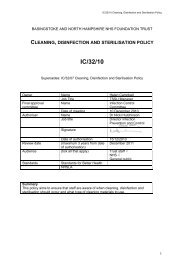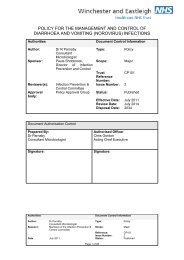Protocol for infection surveillance - Hampshire Hospitals NHS ...
Protocol for infection surveillance - Hampshire Hospitals NHS ...
Protocol for infection surveillance - Hampshire Hospitals NHS ...
You also want an ePaper? Increase the reach of your titles
YUMPU automatically turns print PDFs into web optimized ePapers that Google loves.
Surveillance of Infection <strong>Protocol</strong><br />
Note:<br />
• If an implant has not been inserted, SSIS should be stopped on the 30 th day<br />
after the operation (as <strong>infection</strong> after this time would not meet the definition of<br />
SSI).<br />
• If an implant has been inserted SSIS should continue <strong>for</strong> 1 year after the<br />
operation (as an <strong>infection</strong> may meet SSI definition). Any patients readmitted with<br />
joint <strong>infection</strong> will be monitored by the coordinator.<br />
3.0 The SSI Coordinator Responsibilities<br />
• Collecting data from (medical & nursing notes / clinical personnel / positive<br />
microbiology cultures).<br />
• Analysing data<br />
• Forwarding data to the HPA via a web link<br />
• Acting as a point of contact to receive data from the HPA( quarterly reports)<br />
• Sharing data results<br />
Note: SSIS can be undertaken at local level if deemed necessary<br />
3.1 Data collection<br />
• Review operating theatre lists to identify patients <strong>for</strong> specific chosen category.<br />
• Visit patient from first post- operative day until discharge (three occasions<br />
advised by Health Protection Agency) HPA.<br />
• Use assigned data collection <strong>for</strong>m provided by the HPA.<br />
• Make the patient aware of the relevance of SSIS / confidentiality of<br />
in<strong>for</strong>mation / dissemination of results.<br />
• All patients to receive a booklet on “Monitoring surgical wounds <strong>for</strong> <strong>infection</strong>”(<br />
HPA) Coordinator contact details are on the back of booklet.<br />
• Verbal consent is taken from the patient, to receive a follow up telephone call<br />
between four and six weeks post discharge, regarding wound status.<br />
Alternatively a post discharge questionnaire can be given to the patient to be<br />
completed at 30 day post discharge and returned to the Infection Surveillance<br />
Coordinator. This post discharge <strong>surveillance</strong> is a mandatory requirement by<br />
the SSIS database.<br />
• Liase with microbiology, regarding wound swab results to confirm SSI.<br />
• Collect relevant data via Sapphire computer system :- (ASA score, duration of<br />
operation, grade of surgeon).<br />
• Identify, and monitor patients readmitted with SSI and in<strong>for</strong>m HPA.<br />
• Liase with planning department to confirm admission / discharge list to ensure<br />
that no patients have been overlooked in specific category.<br />
• Check discharge operation code via PMS system.<br />
3.2 Submission of data<br />
• Data is submitted via a password protected electronic weblink to the HPA.<br />
• Each record entered is given a serial number and this is used between the<br />
Trust and the HPA <strong>for</strong> any further correspondence regarding the patient.<br />
• Coordinator keeps own database <strong>for</strong> reference.<br />
3.3 Reconciliation of submitted data<br />
Approximately 4 weeks after the end of the <strong>surveillance</strong> period each participating<br />
hospital will be asked to confirm the number of <strong>for</strong>ms they have submitted <strong>for</strong> that<br />
period and <strong>for</strong> how many of these SSI has been reported. This allows the<br />
Page 4 of 9


